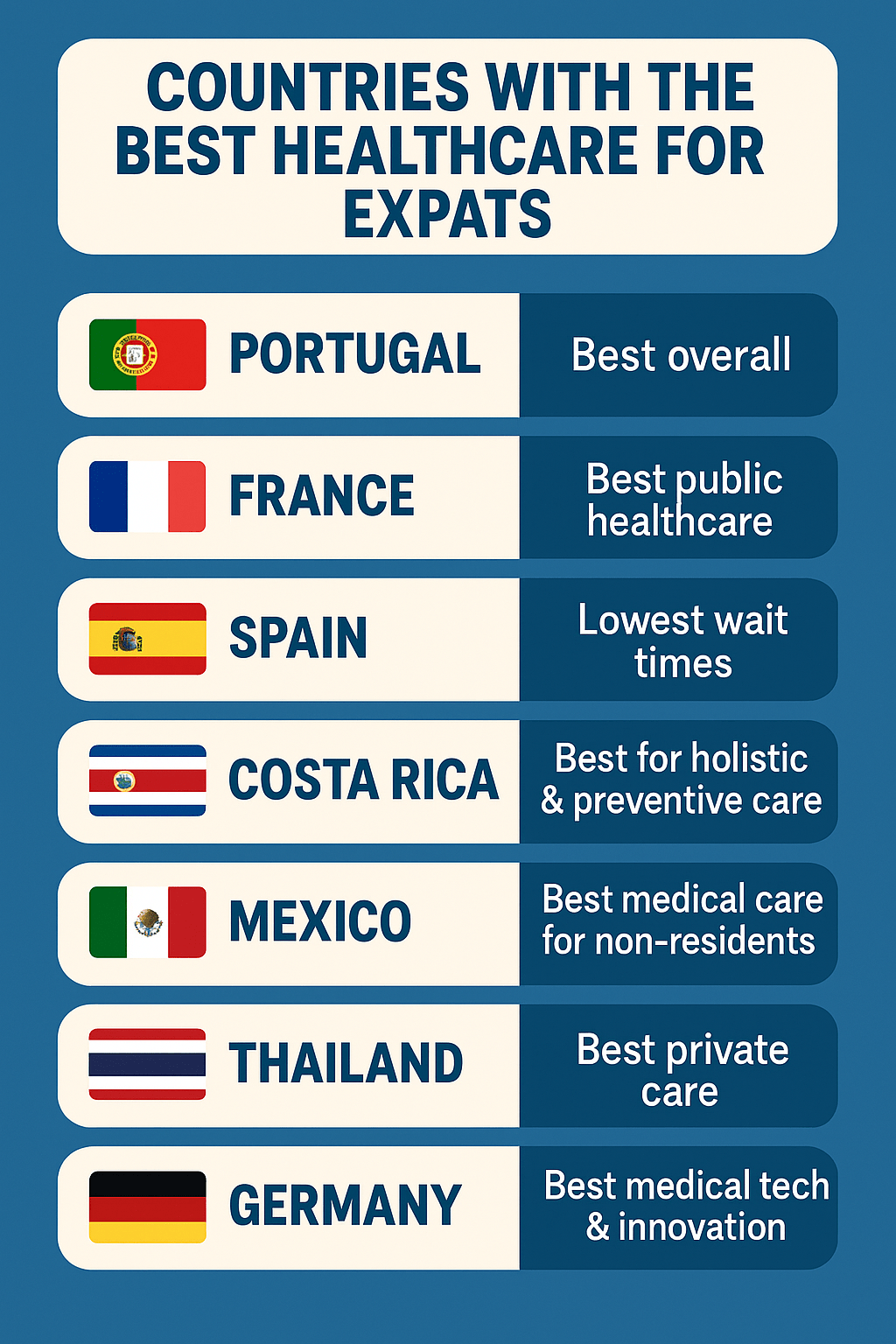Countries With the Best Healthcare for Expats (2025)
Here’s the quick answer: Portugal, France and Spain are our top picks for the best healthcare for expats.
Here’s a closer look at these countries:
- Portugal: Expats have access to excellent care from both public and private sources. High life expectancy also contributes to its place on our list.
- France: France’s overall quality of healthcare and the speed at which expats can apply for coverage earn it the second spot among our top picks.
- Spain: You’ll be able to access primary and emergency care far quicker here than most other areas.
If the above locations don’t measure up as a move destination for other reasons, we’ve listed some other countries with high-quality medical care such as Costa Rica, Mexico, Thailand, and Germany.
After you’ve chosen a destination country, you should begin getting quotes from top international moving companies. Depending on where you’ve chosen to move, maintaining your own means of transportation could also be a necessity. Exploring options for car shipping will help you to avoid the often-higher price of purchasing a vehicle abroad.
|
|
|
|
What to look for in a country’s healthcare system
We’ve rated the top seven options for expat healthcare based on the following factors; research each before you make a healthcare-based relocation decision.
- Access for visa-holders: Look into how long it will take for you to be fully eligible for care. Researching your eligibility process will help you to avoid any latency period in your coverage.
- Cost of care: “Free” healthcare is never free; in most cases, it is subsidized by a combination of taxes and government spending. Research your estimated tax burden and out-of-pocket costs for care, if applicable.
- Wait times: You’ll always have wait times for appointments, but the best healthcare systems should minimize these.
- Quality of care: Look up statistics for a country’s preventable deaths or ailments while under care to determine this.
- Language barriers: Language is an accessibility metric and not indicative of quality. But, if you can’t speak the language, you should move somewhere that caters to this.
- Private vs. public options: Many countries offer both private and public care, but the quality of these can vary. Researching
7 countries with the best healthcare for expats
We evaluated each of these countries’ healthcare systems based on overall quality, accessibility, cost, access to public and private options and more.
Whether you’re shopping around for care once you retire, or are looking to relocate your family overseas as a young professional, we think one of these should fulfill your needs and expectations.
Portugal: Best overall
Portuguese healthcare, accessible through the Servico Nacional de Saude, offers tax-subsidized care for all residents between ages 18 and 65. This includes both citizens and temporary and permanent residents. Public care is free, but even privatized options are relatively low-cost. You won’t break the bank for excellent care.
Healthcare costs
Again, there is no such thing as “free” healthcare. That said, coverage in Portugal is far more affordable than anything you’ll find in the states by any standard. You’ll pay anywhere from 13.25% to 48% in taxes here, depending on income. A portion of that goes towards healthcare and social services.
Private insurance costs between $440 and $1,100 every year. Paying for this may get you slightly shorter wait times at clinics, but isn’t entirely necessary.
Quality of care
Portugal’s life expectancy is nearly 83 years, thanks in large part to its healthcare system. It offers quick response for emergency service and easy access for maternity and childcare, along with mental health services.
Healthcare infrastructure
Portugal’s numerous facilities providing preventative and emergency care often accept both public and private insurance. So, regardless of your coverage, you can get assistance. As a bonus, mental health service is available through public healthcare.
Wait times & access
Wait times are generally short; we haven’t read about any medical horror stories about an inability to get care or be seen by a doctor. Such instances will occur in any system, but aren’t the norm in Portugal. Legal residents also have access, even if they aren’t citizens.
Read our guide to moving to Portugal.
France: Best public healthcare
France’s public healthcare is among the most comprehensive available. As a bonus, more serious, higher-cost procedures receive greater coverage than more run-of-the-mill expenses and appointments. You won’t have to worry about going broke due to illness.
Healthcare costs
France’s healthcare is largely funded from taxes and government subsidies. The system handles about 77% of all costs. Between this and additional optional coverages, citizens and residents pay about 7% of total costs for care. Private insurance pricing is around $1,071 annually, but your pricing will depend on how comprehensive your plan is.
Quality of care
The French government regulates healthcare to help set maximum prices and ensure quality. Numbeo’s health index places France’s system as the seventh best in the world. This is due to its high life expectancy of 83-plus years, coupled with low personal expenses from covered individuals and families.
Healthcare infrastructure
If you’re worried about bankrupting yourself in the possible event of an emergency health visit, then France may be the place for you. Most of its hospitals are state-run nonprofits; this encompasses 3,089 facilities throughout the country, which makes it accessible almost anywhere.
Wait times & access
All citizens and legal residents have access to France’s public healthcare. Whether you’re moving here for a change of scenery for a few years or for a permanent new home, you benefit from this system.
Internations.org mentions wait times between six and 80 days to see a doctor, with only 10 needed on average to see a general physician.
Read our guide to moving to France.
Spain: Lowest wait times
If you’re one of many US residents who would want to move for economic reasons, Spain’s healthcare system is an incentive, along with the country’s climate and cuisine. All costs are paid with taxes, and specialists are easy to access.
Healthcare costs
Once you’re a fully settled legal resident, you’ll pay for most of your basic health needs through your taxes. Primary care visits, emergency hospital visits and similar expenses are low-cost, while some prescriptions require copays.
If you’re a temporary visa holder, you may need private insurance priced between $55 and $220 per month. Legal residents have access to socialized care.
Quality of care
Spain offers some of the best available care through well-trained physicians and staff. Numbeo rates it as the 10th-best country in the world according to its healthcare index, just behind Thailand. This is largely due to its readily-available and reliable primary service network.
Healthcare infrastructure
We recommend moving to a city if access to healthcare is important to you. Rural distances to the nearest hospital make for longer average drive times, with the nationwide average being 16 miles. If you live in a city like Madrid or Valencia, you’re more likely to be within walking distance of a medical facility.
Wait times & access
Spain offers reasonably quick access for primary care at eight to nine days, which is the reason for its placement on our list. If you only have basic care needs, this is a great country to live in. However, specialist appointments can take three to four months after you’ve gotten a referral from your physician.
Read our guide to moving to Spain.
Costa Rica: Best for holistic and preventative care
Costa Rica’s comprehensive access to multiple healthcare professionals for each citizen and resident set it apart. Slightly longer wait times are a drawback, but this is a low-cost option for any who plan to change their home country.
Healthcare costs
Costa Rica’s healthcare system is a low cost option for all age ranges, from children to retirees. Citizens and legal residents pay in. Even if you’re uninsured, a regular checkup would cost you between $60 and $75. Low costs extend to more serious procedures, which makes medical tourism popular.
Quality of care
Costa Rica is known for its holistic approach to modern medicine. Each citizen and resident in the public system is assigned teams of doctors, nurses and community health personnel. Numbeo’s health index gives Costa Rica a low score of 64.3, ranking it 50th in the world. This is due largely to long wait times for specialized care, however.
Healthcare infrastructure
Accessibility is one of this country’s strengths when it comes to healthcare; most residents average less than three miles from the nearest hospital. Primary care offices are typically even closer.
All Costa Rican hospitals are operated by “La Caja,” which administers all health needs. They accept social health insurance. Many doctors work in these facilities while also operating their own private practices.
Wait times & access
Unless you only need regular primary care checkups, wait times are going to be an issue. Depending on your ailment, non-emergency care through a specialist can take months or years. Retirees may want to reconsider a move here, as the average wait time for a hip replacement was reported at over 600 days in 2022.
Read our guide to moving to Costa Rica.
Mexico: Best medical care for non-residents
The IMSS, Mexico’s national healthcare, offers coverage for all citizens and permanent residents at a low cost. With its proximity and low out-of-pocket costs for the uninsured, medical tourism is common in bigger cities.
CNN reported that between 1.4 and 3 million US citizens took advantage of this in 2020 alone. This advantage is limited to higher-population areas, however.
Healthcare costs
If you’re looking to save money on healthcare costs, look no further. Your savings on major treatment and surgery can range upward of 36% here. Bypass surgery, for instance, costs $27,000 in Mexico. Compare this to $123,000 in the US, and it’s easy to see why so many cross the border.
Pricing for Mexico’s socialized care costs between $218 and $590 per year for most citizens and legal residents. Private insurance often costs around $1,700 and up, for comparison.
Quality of care
Mexico offers varied quality of care, depending on where you go for treatment. Private facilities are generally more reliable, but offices operated by public care provide comparable service in high-population areas.
Overall, you can have some peace of mind when you get treatment in Mexico. Numbeo gives it a high rating of 72.5 on its healthcare index, earning it the 22nd place rating among all countries.
Healthcare infrastructure
Mexico has no shortage of hospitals, with more than 4,000 throughout the country. National Library of Medicine data shows that only 1,000 of them are publicly run, but these facilities house 75% of the total hospital beds. These hospitals have varied amenities across public and private sectors. Larger cities are a safer bet if you want specialized care.
Wait times & access
If you have public insurance, your wait times for anything other than basic or routine appointments can range depending on where you’re located. Wait times for surgeries range between 11 and 14 weeks.
Read our guide to moving to Mexico.
Thailand: Best private care
Thailand is another medical tourism hub that features quality facilities and excellent medical staff. Its universal healthcare system covers citizens and working expats alike through tax deductions.
However, you aren’t entirely locked into public care when you move here. Private options are available at a higher rate, and can offer shorter wait times.
Healthcare costs
Thailand’s universal health plans are tax-funded. If you opt for private care, you can expect to pay premiums starting at $1,344 per year. If you’re among the thousands who visit this country each year for care, we recommend that you have private coverage of some kind.
Quality of care
Regardless of your residence status, you’ll be treated to excellent care here. Hospitals conform to Joint Commission International (JCI) standards, making this a hot spot for people all around the world.
Public hospitals are well-regarded, but private hospitals offer expedited wait times and more amenities, including access to greater ranges of treatments. If you only require basic care, we recommend either option. Thailand’s 77.5 healthcare index rating on Numbeo puts it in the top 10 in the world on this scale.
Healthcare infrastructure
Thailand’s aim is to ensure that all citizens and residents have access to healthcare. The National Library of Medicine mentions that a majority of citizens live within 30 minutes of a hospital or care facility. As you get further into the countryside, travel times can range higher.
The country is home to more than 43,000 facilities, including offices and practices of all sizes; most of these are private. However, the majority of large hospitals are state-run for the public. Of these 2,400-plus facilities, just over 2,000 are open to the public.
Wait times & access
Overall, you’ll receive faster care in a private facility. Public hospitals and clinics are noticeably cheaper and are better if you’re on a budget. Some elective or more serious necessary surgeries have long wait times of up to six months or more, but primary care appointments are easy to book.
Germany: Best medical tech & innovation
In Germany, you’ll be required to carry health coverage of some kind. All citizens and residents making less than $76,042 annually are automatically enrolled in public health. This is among the most advanced healthcare systems in the world. As a whole, the country registered 1,380 patents in this industry in 2023 alone. Cutting-edge care is at your fingertips if you move here.
Healthcare costs
Everyone below the above income figure has public healthcare. If you make more than this, you can choose between public and private options. About 14.6% of your gross salary will go towards this system.
If you’re lucky enough to be above this threshold, you can opt into private care. This will cost you between $4,584 and $7,200 per year if you choose this option.
Quality of care
Germany consistently ranks among the best countries in the EU and world for healthcare. The Numbeo health index gives its system an overall rating of 71.9, which places it just below Portugal for overall care, access and more.
Healthcare infrastructure
There is no single governing body for German healthcare. This decentralization between national and state-wide authorities and self-governance aren’t typical, but don’t seem to lead to quality variance between regions.
Overall, Germany has 4.55 physicians per 1,000 people. This high number aids in overall accessibility. Additionally, nearly all hospitals accept public healthcare.
Wait times & access
This country’s healthcare system handles primary and emergency services promptly. If you or a child or elderly family member are in dire need of attention, you’ll be treated to quick care. Germany’s wait time for elective and other surgeries is 31 days.
Read our full guide to moving to Germany.
|
|
|
|
Comparing the best countries for healthcare
If you’re curious about the cost of private healthcare and access to public options, we’ve put together a quick comparison chart of the best available services for expats.
| Country | Public Access | Private Insurance Costs | Wait Times (Public vs. Private) | Specialty Care? |
|---|---|---|---|---|
| Portugal | Free for most essential services through taxes | $440 to $1,100 per year | Med/Low | Via PCP referral for a small fee |
| France | Low costs for essential services | An average cost of $1,071 | Med/Low | Often covered under public care |
| Spain | Free through taxes at point of sale for most services | An average of $840 to $2,616 per year per person | Med/Low | Covered by public subsidized insurance |
| Costa Rica | Low cost through taxes | An average of $3,600 to $8,400 per year per person | Long/Med | At a low cost, relative to US pricing |
| Mexico | Premiums range from $218 to $590 each year per person | An average of $1,700 per year per person | Long/Low | At a low cost, relative to US pricing |
| Thailand | Free for citizens and residents through taxes | Prices start at $1,344 per year per person | Med/Low | At a low cost, relative to US pricing |
| Germany | Free through taxes | An average of $4,584 to $7,200 per year per person | Med/Low | Requires referrals to be covered by insurance |
How to choose the country with the best healthcare
Like with any specialized service, you should fully research your options for healthcare. Especially if public or socialized coverage is a primary selling point when vetting countries before a move, researching the options available in different countries is a necessary step.
The first consideration will be the accessibility of public healthcare. In many locations, you’ll be able to access such care once you’ve established residency and begun paying taxes. Public health plans are subsidized by taxes, with more convenient options offering zero payment at the point of service.
Countries offering a form of socialized or subsidized coverage will also have private insurance options available. This can provide quicker turnaround when seeking essential or specialized services, but will always be a costlier choice.
Additionally, if you’re moving to a country to retire, you should consider access to care for chronic issues you have or could develop. Perusing expat forums online can inform you about first hand experiences in different countries. Expat Exchange and country-specific expat Subreddit sites are valuable resources.
FAQ
What country has the highest quality healthcare in the world?
CEOWorld Magazine rated Taiwan as having the best healthcare in the world. It rated the country at 78.72 on its own 100-point scale. This rating is based on facility quality, infrastructure, overall access to care and more.
How do expats get healthcare?
Expats in any country will have to establish legal residency and begin paying taxes to be eligible for healthcare. Start this process by securing employment in your new home.
What is the best health insurance for expats?
If you’re looking more into private options than subsidized care, Cigna Global, International Medical Group and William Russell are all widely available picks.
Where does the US rank in healthcare quality?
The CEOWorld healthcare rating for the US is 56.7, which earns it the 16th overall spot on its list. The overall score is low due to the high overall amount the states spend on this amenity per capita. Poor outcomes like preventable and treatable deaths affect this rating.
Where in Europe is healthcare free?
Countries that offer free or subsidized healthcare include France, Germany, Austria, Denmark, Norway, Sweden, Spain and Italy. In these locations, you’ll be eligible for tax-funded coverage as long as you’ve established residency.
Where is the best place to retire with good healthcare?
Portugal and Spain are each good options for the elderly for ease of access and overall quality. Costa Rica’s quality preventative care makes it another top pick for retirees.
How we chose the best moving companies
The moveBuddha team has spent nearly 10 years evaluating moving companies using a rigorous review system to identify the best moving companies. Our thorough methodology evaluates each moving company's services, cost, customer service, and reputation:
Moving services (35%):
We verify operating authority, insurance, and service scope against FMCSA/SAFER and state databases. We confirm availability via standardized mystery-shopping calls (packing tiers, storage type, specialty handling, delivery windows, valuation), and then review contracts alongside complaint and claims patterns over time.
Customer feedback (28%):
We run structured post-move surveys through our Better Moves Project with verifiable documentation. We emphasize on-time performance, care of goods, and estimates’ accuracy, and we investigate outliers before they influence scores.
Online reviews (7%):
We aggregate ratings across multiple third-party sites to reduce platform bias, analyze overall trends and company response behavior, and discount obvious spam/fake signals such as sudden bursts, duplicate language, and low-history profiles.
State availability (12%):
We confirm USDOT numbers, broker vs. carrier status, and any required state permits, then score a state-by-state service matrix that accounts for coverage gaps, seasonal limits, and lane strength. We award additional credit for documented cross-border or specialty lanes.
Additional services (12%):
We verify whether add-ons are performed in-house or subcontracted, look for crew training/certifications for high-value or oversized items, count only documented offerings (tariffs, photos, written service descriptions) confirmed via mystery shopping, and reward robust pre-move planning (virtual surveys, itemized crating).
Quotes/Payment options (6%):
We test standardized move profiles to assess estimate type (binding, not-to-exceed, non-binding), line-item transparency, and disclosed surcharges, require clear written policies for deposits, refunds, and cancellations, and award points for secure, flexible payment methods and customer portals.
Not what you were looking for?
Check out other categories that can help you find the information you need!






